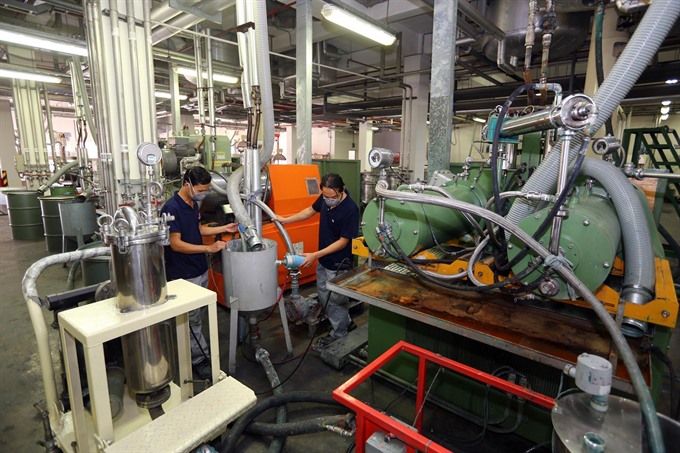 Economy
Economy

Results from the first quarter show Việt Nam’s economy maintains an impressive growth momentum, though the country’s 2018 development model will differ from past occurrences as the rest of the year will experience lower growth rates than the first three months’.
 |
| An industrial production chain in the Southern province of Đồng Nai. — VNA/VNS Photo Danh Lam |
HÀ NỘI — Results from the first quarter show Việt Nam’s economy maintains an impressive growth momentum, though the country’s 2018 development model will differ from past occurrences as the rest of the year will experience lower growth rates than the first three months’.
Such are the findings from a macroeconomic report released yesterday by the Institute for Economic and Policy Studies (VEPR).
VEPR’s Director Nguyễn Đức Thành said that during the first quarter the Vietnamese economy saw exceptionally high growth of 7.38 per cent, the highest in 10 years’ time.
VEPR’s report said that this year’s GDP growth target might clock in at 6.83 per cent, higher than the 6.5 to 6.7 per cent goal set by the National Assembly, as it forecast economic growth rates for the upcoming quarters to reach 6.51, 6.84 and 6.75 per cent, respectively.
Thành said the manufacturing industry continued to be a key driving force for the economy as a whole, while the agriculture, forestry, fishery and service sectors had improved significantly compared to previous years.
The country’s industrial production output increased sharply by 11.6 per cent over the same period last year, with the processing and manufacturing sectors continued a high growth rate of 13.9 per cent.
However, most of the added value in this sector came from foreign direct investment (FDI) companies, as the manufacturing industry received great contributions from foreign enterprises, said Thành.
This posed challenges for sustaining growth in the following quarters as well as for the whole of 2018 and beyond, as the growth target of the economy was increasingly dependent on the FDI sector.
One noteworthy point in the VEPR study was that FDI had declined in 2018’s first quarter, compared with 2017’s last quarter.
During the year’s first three months, newly and additionally registered FDI capital decreased sharply year on year by 27.3 and 54.6 per cent each.
As such, investment capital growth in both the state-owned sector and the FDI sector had decreased by 4.7 and 9.1 per cent year on year, respectively. Yet the private sector posted a significant growth rate of 18.2 per cent.
"This decline, although only temporary, is still worrying for the country’s long-term economic growth, in the context of rising dependence on the FDI sector," Thành noted.
Meanwhile, he said the world economy continued to recover in the past three months, with the US economy showing positive signals from the labour market.
Nonetheless, Director General of the General Statistics Office (GSO) Nguyễn Bích Lâm expressed doubts at such bright prospects, especially with Việt Nam’s economy depending heavily on global aggregate demand.
Speaking at the VEPR’s report announcement, Lâm said that in the context of escalating trade war potential, as well as protectionism, the future of the Vietnamese economy would still be uncertain due to possible shocks from the world market.
Accordingly, as the US implements further tax cuts, Việt Nam’s economy might be adversely affected. When US corporate taxes are reduced, firms would return to their countries, resulting in increased foreign capital inflows poured into the US, instead of going to other countries, including Việt Nam.
On another note, VEPR forecast that quarterly inflation rates for the rest of the year would be 3.44, 3.84 and 4.21 per cent respectively, with the first quarter’s inflation rate slightly improved from 2017, down to 2.66 per cent.
Nguyễn Trí Hiếu, a finance and banking expert, attributed the improvement to appropriate adjustment of public services such as health and education, and partly due to the State Bank’s loosening of monetary policy as core inflation tends to rise slightly from a relatively lower level.
Based on data on commercial output, export and import turnover, as well as credit growth, investment and manufacturing indexes, the VEPR estimates that the Vietnam Economic Performance Index (VEPI) was 6.6 per cent for the first quarter in 2018.
This number, though well below the 7.38 per cent forecast released by the GSO in late March, is significantly higher compared to 2017’s index of 5.77 per cent and 2016’s of 4.89 per cent at the same period.
However, the number of newly established enterprises also fell sharply in March, with only 8,082 firms registered in total, as compared to the same period last year at 10,814, while the number of businesses suspended in the first quarter is around 21,115, the highest since 2016.
First quarter employment statistics also did not correspond to the high economic growth rate, as there were few new jobs created despite the high level of growth, which raises questions about the quality and intrinsic strength of domestic economic sectors, said the report.
The quarterly report was completed by the VEPR with support from the Konrad Adenauer Stiftung (KAS). — VNS




